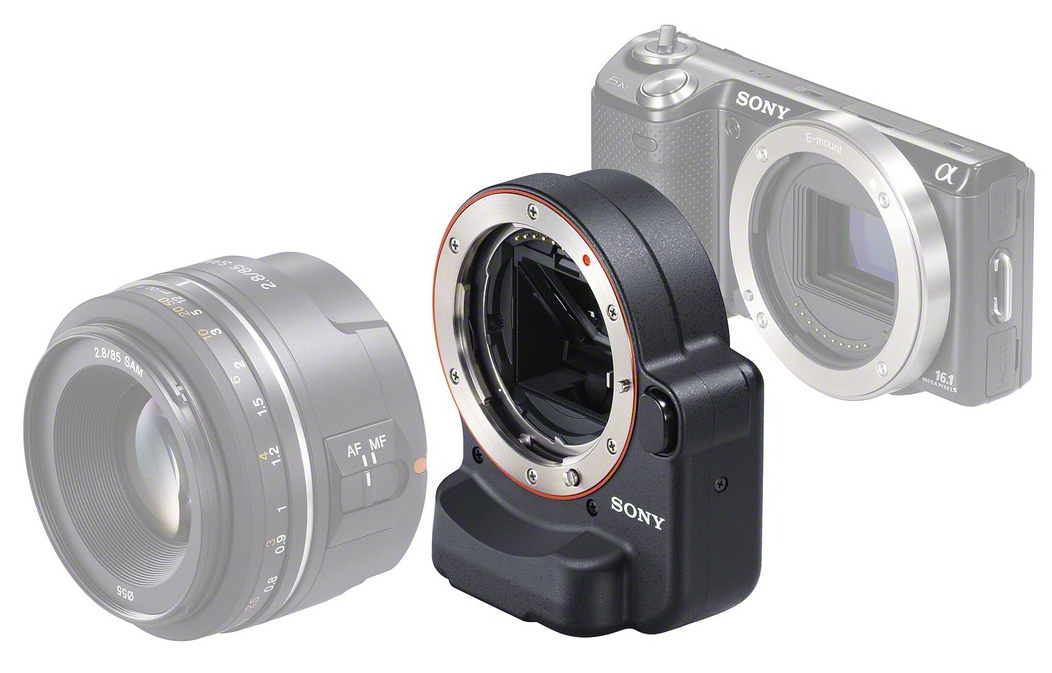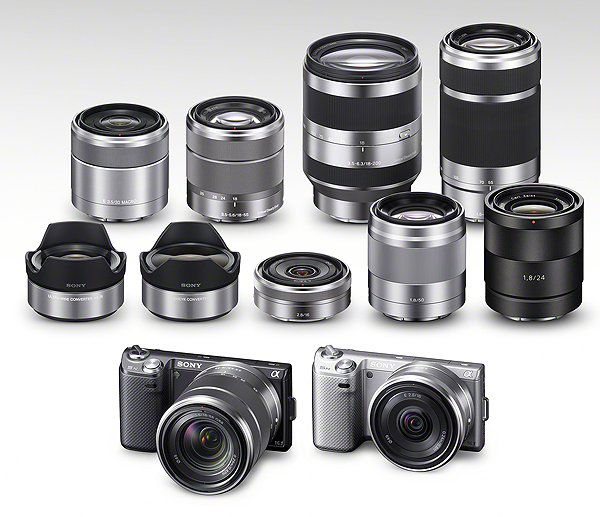An invitation to a Sony event on August 15th seemed perfectly timed for the announcement of the Alpha 77 and 65, NEX-7 and NEX-5n. In fact, those cameras were launched in Greece on August 24th – and Photoclubalpha, as a very minor player in this business, was not on the guest list. Nor could we have attended if invited as the diary was already full that week (four days of the Master Photography Awards judging and their Fellowship and Associate annual admissions to be covered).

Wild geese – red-breasted geese, Branta ruficollis, fleeing the camera (©Shirley Kilpatrick, A580, Sigma 18-250mm OS)
However, when the invitation to an event at the London Wetland Centre was issued, with strict limits on the numbers able to register and some air of importance, we decided to do the 700 mile round trip, stay a couple of days for some stock photo shooting, and hope for the best. My mistake, one of our photo mag friends said he didn’t attend because he was tipped off it was not really for photo mags. Even so, most of those present seemed to be photo press not wildlife press…
The Wetland Centre, while a fairly poor location for photography due to the extreme distance the hides are from the wildlife, would have been a good place to launch an Alpha 77 and Alpha 65 (both equipped with improved GPS) and teamed up with the long-awaited 500mm f/4.5 Sony Apo G SSM.

Sadly, it all turned out to be a wild goose chase for Photclubalpha. The object being launched was the new Sony invention of 3D digital binoculars, the DEV-3 and DEV-5 models aimed at high end binocular users wanting to spend their £1300-£2000 on something novel. While impressive enough if you want an electronic viewfinder version of binoculars, they are almost useless to photographers as the still capture resolution is a mere 7.1 megapixels from a small EXMOR-R back illuminated sensor. JPEG only, no raw, no control of still capture settings beyond very basic adjustments.
Digital scoping
Sony took their lead on development, it seems, from digiscoping. Their research showed that serious bird watchers have been fixing compact digital cameras (and occasional DSLRs) to the end of high power spotting scopes to secure unfeasibly long focal length equivalents and capture acceptable frame-fillers of bird life from the distances bird life prefers to remain.
Their research also showed that bird watchers will spend £2000 without hesitation on a high end pair of binoculars.
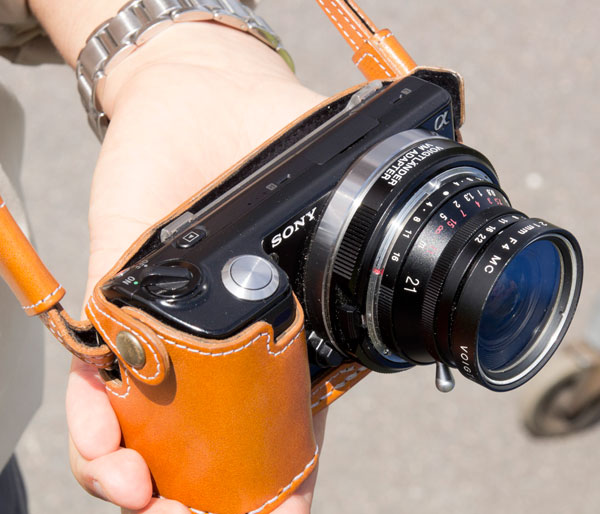
Now I’m going to stick my neck out and suggest that much of the appeal of digiscoping is exactly the same as the appeal of adaptors and alien lenses used on the NEX. One of Sony’s own Japanese executives at the event was wearing a NEX-5 with a Voigtländer adaptor and a 21mm f/4 Voigtländer lens in Leica M mount.
Digiscopers like their rigs of camera and scope because part of the challenge is to create a perfect digiscoping set up and discover the best cameras, scopes, eyepieces and adaptors for the job. Creating the equipment is part of the hobby. Also, the scope continues to have a purpose of its own as an optical device. It does not matter that the combo weighs 4.5kg and needs a tripod (even that is part of the Meccano-Lego factor, building your personal solution).
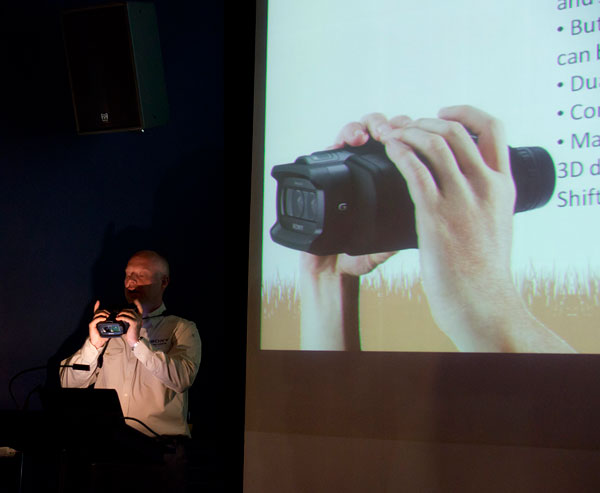
Paul Genge of Sony explained how much lighter the system will be than digiscoping – but omitted the fun of making your own digiscoping rig, which is half the point of it
The Sony Electronic HD video capable binoculars do one thing well, and only one thing. They capture HD1080p video at 50fps (60fps in the USA) with the option to use both sensors for 3D video, which is interlaced instead. With lens-based stabilisation counteracting complex rotational movements which may affect each of the two lenses reciprocally, they are a technical masterpiece.
Unfortunately, they don’t have the new high resolution EVF of the Alpha 77/65/NEX-7, but use one closer to the Alpha 55 in detail. Actually, they use two, fed by separate sensors, as a true binocular system with the eyepieces adjustable for interpupillary distance and dioptre settings. They can simulate using electronic screens a binocular view, with a 16:9 or 4:3 format (the sensor is actually 4:3 ratio, and cropped for HD).
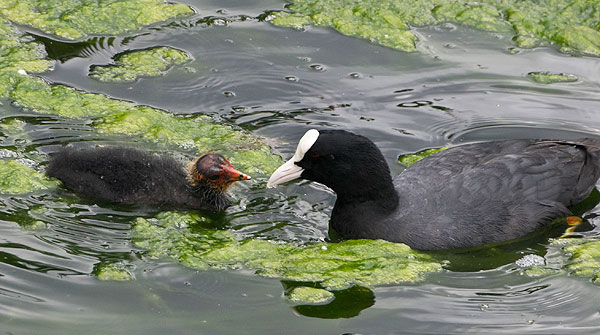
This was not at the Wetland Centre (mother coot feeding chick) but at Kew Gardens, which actually put photographers much closer to wildlife more accustomed to humans at close quarters (©Shirley Kilpatrick, A580, Sigma 18-250mm)
But in my pocket was a Minox 6x16X monocular, and in Shirley’s bag a similar Minox 8x16X – lovely little Zeiss-optic metal devices intended for concerts and travel. So I was able to compare the view through the 10X DEV-3 with a simple, monocular, low-cost Minox optical image. There is simply no way ever that any serious nature-watcher would wish to observe the world through the electronic version. It is a world without the individual colours within the feathers of a bird; indeed, it doesn’t even have the individual feathers. Compared to looking through the electronic finder, the optical view was breathtaking in crystal clarity and brightness with exquisite detail enabling the identification and study of subjects.
Real birders use 20×30, 20×50, even up to 30X (Olympus zoom binoculars, for example). Some may choose stabilised binoculars, offered by Canon in specifications including an 18 x 50 with all-weather body. The stabilised view of the DEV-3 and DEV-5 is still a good feature and goes some way to make up for the lack of true image detail.
The zoom of these devices is not the same as the limited range of binocular zooming – and the same goes for focusing. They can focus down to 80cm and retain 3D video, due to the close spacing of the objective lenses; in 2D, macro shots close to the lens are possible, and indoors you can even shoot normal people and group shots though there’s no flash of course. In this sense the Sony invention goes beyond being a binocular, just as much as it falls short of being a true one.

If this looks familiar, the embedded front bit is basically a Sony Handycam TD10E lens and sensor assembly
That’s because all the DEV-3 and DEV-5 actually consist of is the front part of the Sony Handycam TD10E with some optical and design modifications, and a stereo viewing system bolted on the back. This £1300 camcorder offers a 17X zoom range but it’s hard to express that in the same terms as binocular magnification. Its recording is technically identical, the same bitrate and quality of 1080p or 3D 1080i, and its stills are the same 7.1 megapixel maximum. This was admitted by Paul Genge, Sony’s technical sales executive, when showing us the DEV-5.
Most oddly for the target markets of birding, wildlife, safaris, peeping toms, police, military, racegoers and suchlike the DEV models are not ruggedized or water and dust proof. They do accept an external microphone but it’s most unlikely any camera-mounted mic, even a special shotgun unidirectional type, will satisfy wildlife film makers.
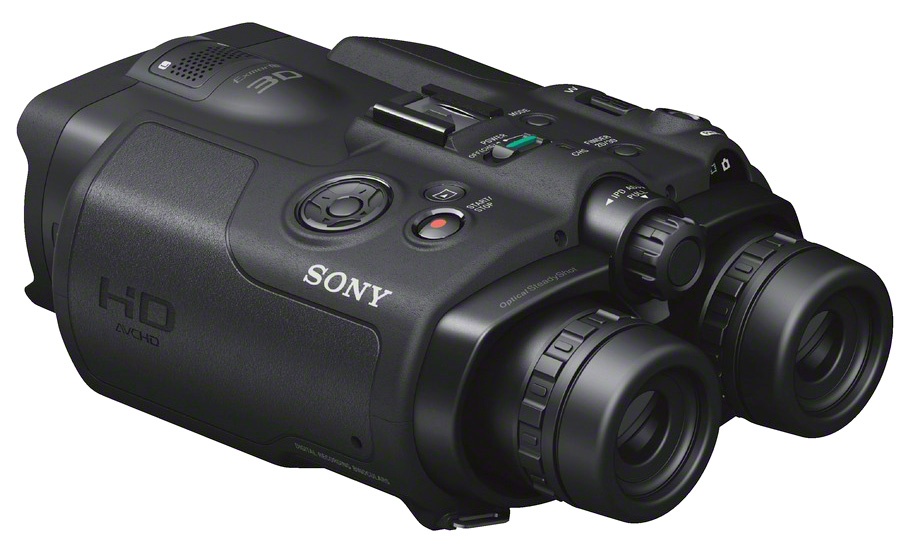
Of course, the DEV-5 does include GPS and will record the location of filming but there’s no built-in magnetic compass so it does not tell the full story. The DEV-3, with its lower maximum zoom power, omits the GPS and that is reflected in the price (update – we are told by Paul that the interest shown since the launch is almost entirely in the higher end model with GPS – it provides valuable evidence to bird-spotters, and evidence appears to be what they value most).
Despite the two lenses, the DEV models do not capture 3D stills – only 3D video. Binocular experts will point out that the closely spaced objectives reduce the 3D impression given by long-range binos which have a wider front lens separation. This is vital for close focusing. You either must have adjustable front lens spacing for close-ups (difficult to achieve) or a very limited true stereoscopic effect.
No test
We were not allowed to take any footage with the DEV-5 or DEV-3 though Paul showed some tests of his own, taken during a week trying out the new product all round Britain (between visits to key dealers such as Park Cameras, who are selling them at the Bird Fair which opened on August 19th at Rutland Water, with a free extra chunky high power battery thrown in).
Report from this event, added September 8th – Paul Genge says it was a great success, with over one thousand visitors to the Sony stand trying the DEV models. Many of these visitors had tried digiscoping but had consistently poor results despite much investment in bits and pieces to get it working, and saw the DEV concept as a simple, elegant, nearly perfect solution to their problems.
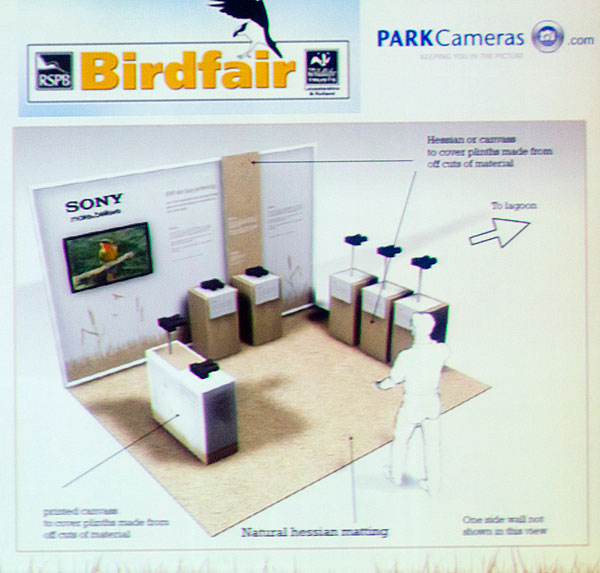
Birdfair at Rutland Water on August 19th – the blueprint above turned into a real Sony DEV-3/5 booth. Park Cameras offered special deals as the first main distributor and took several orders, all for the DEV-5 model, on the day.
The results looked very impressive as HD movies.
However, there are a few functions which the DEV models could have included had they been designed from the ground up and not based on an existing camcorder. One is pre-shot capture, where the buffer is constantly recording a rolling second or two of video, to be included with the take when you press the button to film. This avoids missing the critical first part of movement of the subject which triggers your own reactions.
The second is slow-motion capture at reduced resolution; 50/60p is already capable of half-speed playback and the shutter speed control use in the DEV models favours better motion freezing than some camcorders which aim for purely cinematic shutter speeds (1/30-1/50th and so on). Had controls been added to force fast shutter speed capture that is very useful for analysing wildlife film frame by frame, or extracting a valuable still image. Had 720p at 100/120 frames per second been enabled, that enables quarter-speed playback of action.
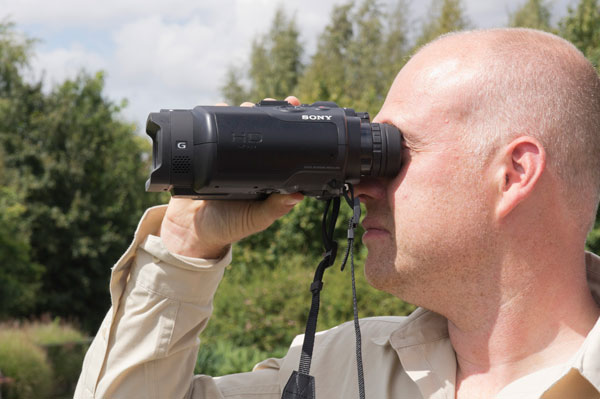
Single-handed operation by Paul Genge – but he’s had a week of weight training before the event! They are actually pretty light, just rather large.
Finally, make no mistake these babies are big. They are not overly heavy, as they are mainly empty plastic shaped to look like a military device. But they are not especially travel friendly, or all that easy to pop under your jacket in a cloudburst.
The ultimate use
Shirley’s verdict was – these are just made for festivals and stadium gigs! The one use not mentioned in Sony’s presentation, and a very popular use for binoculars and camcorders alike, is to see stage performances better and record music. Those little Minox monoculars we carry everywhere with us now were bought some years ago, en-route to an R.E.M concert. And sure enough, from our vantage point in Stirling Castle, they were a good investment.
Now if the tiny Minox monocular happened to include a 1080p HD movie recorder – which it very easily could in terms of size, think of mobile phones, Sony Bloggie and the like – it would be an even better concert companion.
The Sony DEV digital binoculars might get in past some security staff but we reckon they will soon be recognised and banned from events.
Nothing new
The first time we discovered binoculars combined with a camera, we actually got to be the first UK journalists to write them up. This was the Nicnon binocular camera, in its final version around 1975 (it had existed in a cruder design from the late 1960s) – it worked fairly well, but didn’t give any more real magnification than a regular 35mm camera with a 165mm lens and had a useless fastest shutter speed of 1/250th, only barely short enough to avoid camera shake in every shot and never able to stop action.
Later on we tried the Tasco 110 binocular camera but the results were almost useless. Today, of course, we have pocket digicams with zoom lenses going to an equivalent of over 500mm and a resolution which matches 35mm not 110. These can even challenge the concept of the DEV-3 and DEV-5, though I doubt that anything made comes close to the HD video quality. In the end, something is new about the DEV-3 and DEV-5, and that is the HD video in a binocular form.

We can only wish Sony the best of luck with this product. Any serious wildlife watcher or bird spotter will need their regular optical binoculars and their regular tele-equipped DSLR in addition to the DEV-3 or DEV-5. Regardless of six hour battery life and other commendable features, they simply do not and can not replace the other key equipment used in the field, with the exception of digiscope rigs or tele-capable camcorders.
They will sell to wealthy gadget enthusiasts and garden birdwatchers with poor eyesight and big flat screen teles. Over 50s, get in an orderly queue now…
For us, our four-day venture to the former wastelands of Barnes was a wild goose chase (we did see a few). Life was enlivened by road closures due to Olympic ‘test run’ cyclists. This product is not really of any interest to our dedicated photographer readership, for £2000 an Alpha 65 and 70-400mm SSM G would be a better investment for everything except the 3D video. And the market murmur is that 3D has failed, yet again. It’s simply not selling.
Get the full PRESS RELEASE here.
– David & Shirley Kilpatrick












